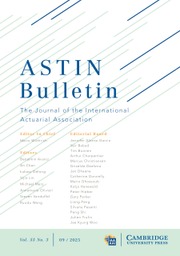No CrossRef data available.
Article contents
The Mincing Machine Revisited
Published online by Cambridge University Press: 29 August 2014
Extract
For the 4th ASTIN colloquium in Trieste (1963) Robert E. Beard [1] had initiated the topic of extreme value theory and its application to actuarial problems. The impetus came from Gumbel's book [2], published in 1958, and the idea of applying extreme value theory ran about as follows:
Problem: Given: The size of the largest claim observed = XN
The number of observed claims = N.
Find: The excess of loss premium for a portfolio of independent risks identical with those under observation.
The idea was to use Gnedenko's limit distribution for the wide class of distribution functions with an unlimited tail and finite moments, the “exponential type” in Gumbel's terminology, and to calculate the excess of loss premium on the basis of this limit distribution.
The discussion in Trieste was very lively and culminated in Jan Jung's citation of Jan Jung [3]: “There is a natural law which states that you can never get more out of a mincing machine, than what you have put into it. That is, if the reinsurance people want actuarially sound premiums, they must get a decent information about the claim distribution”. In more mathematical language: The brilliant idea of Bobbie Beard is unfortunately leading to a non-robust procedure. A deviation in the true (but unknown) underlying distribution may lead to completely different results.
In any case the mincing machine argument seemed so powerful that we have had little reconsideration of the above problem at subsequent ASTIN colloquia. It may therefore be worthwhile to have another look at the problem now, i.e. more than ten years after the Trieste colloquium.
- Type
- Research Article
- Information
- Copyright
- Copyright © International Actuarial Association 1975


